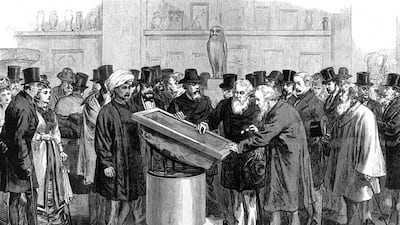For centuries they were an impenetrable mystery. Hieroglyphs, pictorial writing found on ancient monuments, represented the lost language of the Egyptian pharaohs.
The code was finally cracked 200 years ago with the presentation on September 27, 1822, to a Paris academy by Jean-Francois Champollion, a gifted linguist with a passion for ancient Egypt.
Five days earlier, Champollion had made the final breakthrough, a moment so exciting that after shouting “I’ve got it,” he fainted and had to spend the next few days in bed to recover.
At the heart of the mystery was the Rosetta Stone, a 720 kilgram slab of granodiorite, a rock similar to granite, and now housed in the British Museum in London.
The story of the Rosetta Stone is almost as complex as the decoding of the hieroglyphs inscribed on its surface.
It was discovered in July 1799 during renovations to a fort at Rosetta, now called Rasheed, on the Nile Delta. Napoleon had invaded Egypt the previous year, bringing not just an army of troops but also scholars of Egyptian history, with which Napoleon had become obsessed.
The significance of the Rosetta Stone was almost instantly recognised. It carried three panels of text, one in hieroglyphs and another in a then-unknown language.
The third was ancient Greek, a language well known and understood by 19th-century classical scholars. That revealed the stone — or stele — was a proclamation to establish the authority of the then child-pharaoh Ptolemy V, and was carved around 186BC.
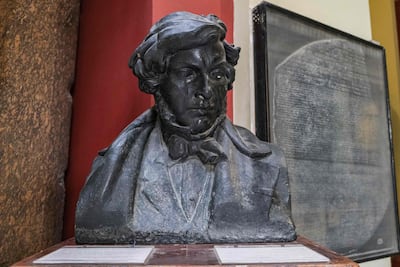
It also became clear that the other two panels carried exactly the same text. Suddenly the door opened to understanding hieroglyphs by comparing them with Greek.
Copies of the text began to circulate widely among scholars in Europe and even the US, but the actual stone was on a different path. Napoleon’s fleet had been destroyed by Admiral Horatio Nelson at the Battle of the Nile in 1798, and his demoralised army finally surrendered to the British in 1801.
Despite French protests, the Rosetta Stone was taken as a spoil of war and presented to King George III, who gave it to the British Museum where it has been displayed ever since.
The hieroglyphs, though, remained a mystery. Much of the text was damaged or missing, and so little was known, it was not clear if they should be read left to right, or the reverse or even up and down.

One popular theory was that they were not even a written language but instead expressed spiritual ideas.
The first breakthrough came from an English doctor, Thomas Young, who began studying the stone in 1814. Young, known as the “Phenomenon” for his scientific discoveries, eventually deduced that the hieroglyphs were phonetic when they involved names, including Ptolemy.
Young’s work was then taken up by Champollion in 1820. Working on the theory of phonetics, he eventually realised that all hieroglyphs were phonetic and that they could also be pictorial. Several hieroglyphs could also represent one word, breaking it into consonants.
It was an extraordinary achievement. Hieroglyphs had developed as a written form of ancient Egyptian from around 3,300 BCE and had become extinct by the 4th century AD.
They were designed to be read only by the most educated, including priests, at a time when most people were virtually illiterate. This was where the second panel on the Rosetta Stone came in. It was in Demotic, a script based on alphabet symbols rather than hieroglyphs and far easier to read and write. Over time it replaced hieroglyphs in everything but religious texts and evolved eventually into Coptic, the language of Egypt's indigenous Christians.
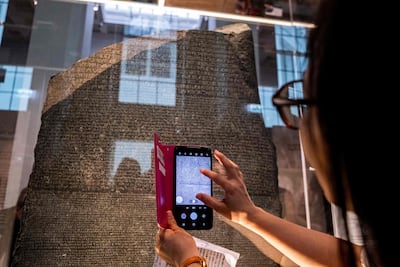
The first Demotic words on the stone were also translated by a French man, Silvestre de Sacy. An expert in Arab languages, he taught and encouraged Champollion in his early work, but eventually fell out with him, calling his rival a fraud.
Likewise, Champollion and Young were initially complimentary about each other's work, but relations cooled over who should take credit for the discovery — the English or the French?
Neither lived long enough to appreciate their fame. Champollion died in 1832 aged 41 and Young in 1829 at 55. Only de Sacy, his contribution largely forgotten, enjoyed old age, dying at 79 in 1838.
The Rosetta Stone can be found today in Room 4 of the British Museum, part of its collection of Egyptian sculptures, of which it is the greatest treasure.
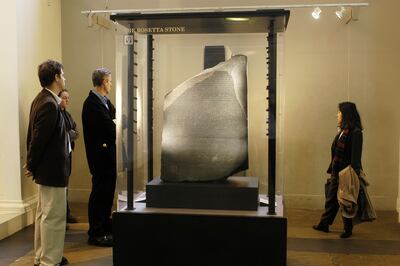
Now displayed behind protective glass, it has been there for 220 years, except for a period in the First World War when it was moved to a tunnel 50 feet underground as protection against air raids.
Egypt, though, excluded from decisions about the stone’s future since the end of the 18th century, would like to have it back.
As reported in The National last month, the renowned Egyptian archaeologist Dr Zahi Hawass has launched a petition for the return of three of his country's most prized artefacts including the Rosetta Stone, a Zodiac ceiling in the Louvre in Paris, and a bust of Queen Nefertiti held by Berlin’s Neuse Museum.
“The Rosetta Stone is the icon of Egyptian identity”, he said in an exclusive interview. “The British Museum has no right to show this artefact to the public.”
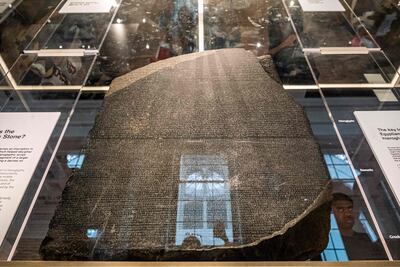
For its part, the British Museum says no official request has been made for the stone’s return. The subtext, as with the Elgin Marbles demanded by Greece, is that millions more people from around the world have been able to see the stone in London than if it was in its original home.
Later this year the new Grand Egyptian Museum is due to open in the shadow of the pyramids in Cairo. Although there is no place yet for the Rosetta Stone, among other artefacts are the contents of Tutankhamun’s tomb.
The archaeologists who found the tomb In November 1922 first knew it was Tutankhamun because they could read his name on the door seals — all thanks to the work of Champollion a century earlier.
